
The Lamiaceae or Labiatae are a family of flowering plants commonly known as the mint, deadnettle or sage family. Many of the plants are aromatic in all parts and include widely used culinary herbs like basil, mint, rosemary, sage, savory, marjoram, oregano, hyssop, thyme, lavender, and perilla, as well as other medicinal herbs such as catnip, salvia, bee balm, wild dagga, and oriental motherwort. Some species are shrubs, trees, or, rarely, vines. Many members of the family are widely cultivated, not only for their aromatic qualities, but also their ease of cultivation, since they are readily propagated by stem cuttings. Besides those grown for their edible leaves, some are grown for decorative foliage. Others are grown for seed, such as Salvia hispanica (chia), or for their edible tubers, such as Plectranthus edulis, Plectranthus esculentus, Plectranthus rotundifolius, and Stachys affinis. Many are also grown ornamentally, notably coleus, Plectranthus, and many Salvia species and hybrids.
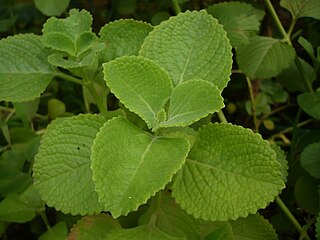
Coleus amboinicus, synonym Plectranthus amboinicus, is a semi-succulent perennial plant in the family Lamiaceae with a pungent oregano-like flavor and odor. Coleus amboinicus is considered to be native to parts of Africa, the Arabian Peninsula, and India, although it is widely cultivated and naturalized elsewhere in the tropics where it is used as a spice and ornamental plant. Common names in English include Indian borage, country borage, French thyme, Indian mint, Mexican mint, Cuban oregano, soup mint, Spanish thyme. The species epithet, amboinicus refers to Ambon Island, in Indonesia, where it was apparently encountered and described by João de Loureiro (1717–1791).

Mentha aquatica is a perennial flowering plant in the mint family Lamiaceae. It grows in moist places and is native to much of Europe, northwest Africa and southwest Asia.
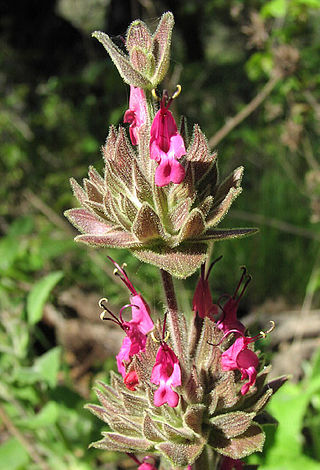
Salvia spathacea, the California hummingbird sage, hummingbird sage, or pitcher sage, is a species of flowering plant in the family Lamiaceae, native to southern and central California growing from sea level to 610 m (2,001 ft). This fruity scented sage blooms in March to May with typically dark rose-lilac colored flowers. It is cultivated in gardens for its attractive flowering spikes and pleasant scent.
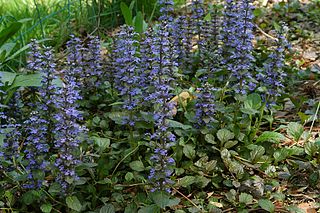
Ajuga reptans is commonly known as bugle, blue bugle, bugleherb, bugleweed, carpetweed, carpet bugleweed, and common bugle, and traditionally however less commonly as St. Lawrence plant. It is an herbaceous flowering plant in the mint family Lamiaceae, native to Europe. It is invasive in parts of North America. It is also a component of purple moor grass and rush pastures, a Biodiversity Action Plan habitat in the United Kingdom.

Ballota nigra, black horehound, is a perennial herb of the family Lamiaceae. It is native to the Mediterranean region and to central Asia and it can be found throughout Europe. It is also naturalized in Argentina, New Zealand, and the Eastern United States. It blooms in the Northern Hemisphere from May to August.

Lepechinia fragrans is a flowering herbaceous shrub known by the common names island pitchersage and fragrant pitchersage. It is a member of the Lamiaceae, or mint family, but like other Lepechinia, the flowers are borne in racemes instead of in mintlike whorls.

Galeopsis tetrahit, the common hemp-nettle or brittlestem hempnettle, is a flowering plant in the family Lamiaceae, native to Europe and northwestern Asia.
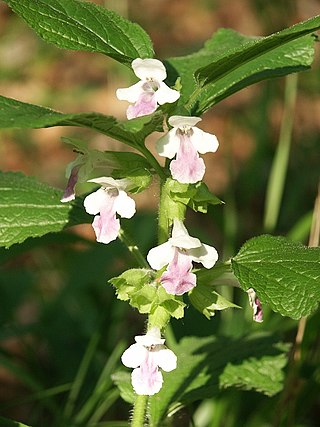
Melittis melissophyllum is a species of flowering plant in the mint family, Lamiaceae. Its common name is bastard balm. It is the only species in the monotypic genus Melittis. The genus name is derived from the Greek melitta, which is in turn from melissa.

Lamium maculatum is a species of flowering plant in the family Lamiaceae, native throughout Europe and temperate Asia.
Anisomeles ajugacea is a species of flowering plant in the family Lamiaceae and is endemic to Queensland. It is a low-lying shrub with egg-shaped to heart-shaped stem-leaves with a gradual transition to flora bracts on the upper part of the stem, and small groups of pink flowers.

Ajuga pyramidalis, commonly known as pyramidal bugle, is a flowering plant of the genus Ajuga in the family Lamiaceae. It is a native plant in Europe.

Scutellaria incana, the hoary skullcap or downy skullcap, is a flowering plant in the family Lamiaceae and is native to North America. It is a perennial flowering plant and is primarily found in the eastern United States as well as some parts of the Midwest.

Galeopsis bifida is an annual plant native to Europe and Asia but now found in Canada and the northeastern, midwestern parts of the United States. It has many common names such as bifid hemp-nettle, split-lip hemp-nettle, common hemp-nettle, and large-flowered hemp-nettle. The genus name means weasel-like, referring to the corolla of the flower. It is often confused with other species of Lamiaceae such as Mentha arvensis, Dracocephalum parviflorum and Stachys pilosa.
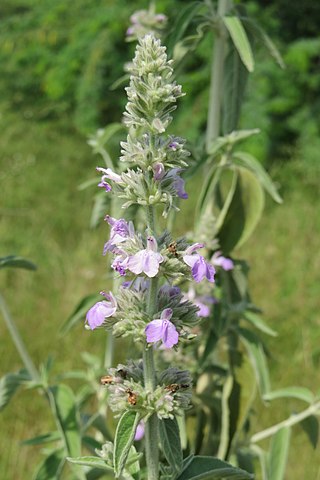
Anisomeles malabarica, more commonly known as the Malabar catmint, is a species of herbaceous shrub in the family Lamiaceae. It is native to tropical and subtropical regions of India, and Sri Lanka, but can also be found in Malaysia, Bangladesh, Myanamar, Bismarck Archipelago, Mauritius, Andaman Is. and Réunion. Growing up to 2 m high, it has narrow green leaves 3–8 cm in length, and 1.5–3 cm wide. It is pollinated by sunbirds and carpenter bees, and bears purple flowers in mid spring, though it may also bear the flowers throughout the year. Originally used in Sri Lankan and Hindi folk medicine, the current main uses are medicinal, aromatics and cosmetics.

Leucas aspera is a plant species within the genus Leucas and the family Lamiaceae. Although the species has many different common names depending on the region in which it is located, it is most commonly known as Thumbai or Thumba. Found throughout India, it is known for its various uses in the fields of medicine and agriculture.

Thymus pulegioides, common names broad-leaved thyme or lemon thyme, is a species of flowering plant in the family Lamiaceae, native to Europe. Growing to 5–25 cm (2–10 in) tall by 25 cm (10 in) wide, it is a small spreading subshrub with strongly aromatic leaves, and lilac pink flowers in early summer. The specific epithet pulegioides highlights its similarity to another species within Lamiaceae, Mentha pulegium (pennyroyal).
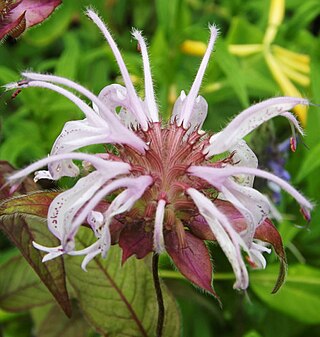
Monarda bradburiana, the eastern beebalm or Bradbury's beebalm, is a species of perennial flowering plant in the mint family, Lamiaceae, that is native to much of the southeastern United States.

Phlomoides tuberosa, the sage-leaf mullein, is a perennial herbaceous flowering plant in the family Lamiaceae, native to China, Kazakhstan, Kyrgyzstan, Mongolia, Russia; SW Asia and Europe. Enlarged, tuberous roots give rise to erect stems to 150 cm bearing purple-red flowers.

Galeopsis pubescens, also known as the hairy and downy hempnettle, is a herbaceous annual plant species in the family Lamiaceae, that can be found growing in various European countries.



















